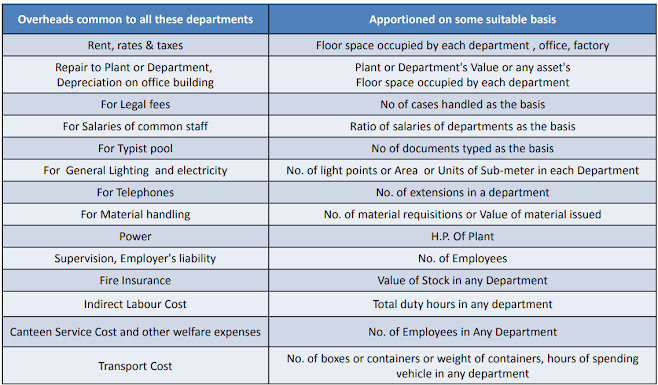Allocation, Apportionment and Reapportionment of Overheads
The objective of Cost Accounting is classifying costs and recording an appropriate allocation of expenditure for the determination of the costs of products or services, and for the presentation of suitably arranged data for the purpose of control and guidance of management
A) Allocation of Overheads
- When items of cost are identifiable directly with some products or departments such costs are charged to cost centres. This process is known as cost allocation.
- It is the charging of discrete, identifiable items of cost to cost centres or cost units.
- It is complete distribution of an item of overhead to the departments or products on logical or equitable basis is called allocation.
- Where a cost can be clearly identified with a cost centre or cost unit, then it can be allocated to that particular cost centre or unit.
- Allocation is the process by which cost items are charged directly to a cost unit or cost centre.
- Cost allocation calls for two basic factors –
– Exact amount of cost should be computable.
Cost Allocation- Examples
- Electricity charges can be allocated to various departments if separate meters are installed
- Depreciation of machinery can be allocated to various departments as the machines can be identified
- Salary of stores clerk can be allocated to stores department
- Cost of coal used in boiler can be directly allocated to boiler house division.
- Wages paid to workers of service department can be allocated to the particular department.
- Indirect materials used by a particular department can also be allocated to the department.
Thus allocation is a direct process of identifying overheads to cost units or cost centres. So the term allocation means allotment of whole item of cost to a particular cost centre or cost object without any division.
B) Apportionment of Overheads
- Apportionment of overhead costs means to divide total cost of overhead among different departments or branches or cost centers of a company.
- We need the steps of apportionment of overhead costs when there are many departments or cost centers of any company because when we know the overhead cost of each department, we can find the total cost of department.
- With this, we can compare the revenue of each department with their total cost.
- Then take decisions relating to particular department.
Basis for Overhead Apportionment
C) Reapportionment of Overheads
Reapportionment of overheads from service departments to production departments is a process used in cost accounting to allocate indirect costs fairly and accurately among the departments within an organization. Service departments are those that provide support services to production departments, such as maintenance, human resources, or administrative services. These service departments typically incur overhead costs that need to be allocated to production departments based on their usage of the services provided.

Comments
Post a Comment